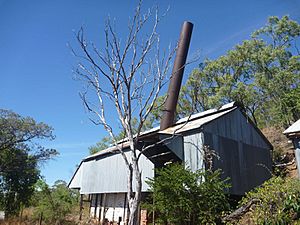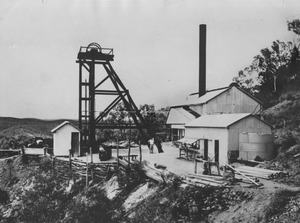General Grant Mine facts for kids
Quick facts for kids General Grant Mine |
|
|---|---|

General Grant Mine and Winding Plant, 2012
|
|
| Location | Off Dimbulah - Mount Mulligan Road, Kingsborough, Shire of Mareeba, Queensland, Australia |
| Design period | 1870s - 1890s (late 19th century) |
| Built | c. 1878 - 1930s |
| Official name: General Grant Mine and Winding Plant | |
| Type | state heritage (built, archaeological) |
| Designated | 21 October 1992 |
| Reference no. | 600683 |
| Significant period | c. 1878-1930s (fabric, historical) |
| Significant components | workshop, shaft, chimney/chimney stack, shed - winding, machinery/plant/equipment - mining/mineral processing, shed/s, terracing, mullock heap, adit, forge/blacksmithy |
| Lua error in Module:Location_map at line 420: attempt to index field 'wikibase' (a nil value). | |
The General Grant Mine is an old gold mine located near Kingsborough in Queensland, Australia. It's a special place because it shows us how mining used to happen a long time ago. People worked here from around 1878 until the 1930s. Today, it's protected as a heritage site, meaning it's an important part of Queensland's history.
Contents
Discovering Gold at General Grant Mine
The Hodgkinson Goldfield
The area where the General Grant Mine is located was once part of the Hodgkinson Goldfield. This goldfield was officially opened on June 15, 1876. It was similar to another big goldfield called the Palmer. However, the Hodgkinson field mostly had "reefing gold." This means the gold was found in veins within rocks, not loose in riverbeds.
The main mines in this area were near towns like Kingsborough, Thornborough, and Northcote. The Hodgkinson field often struggled because it didn't have enough money, or "capital," to develop properly. Even though people were hopeful until the early 1900s, by 1908, it was clear the gold production was too small. So, in 1909, it became part of the Chillagoe Gold and Mineral field.
Early Gold Production
When the Hodgkinson Goldfield first opened, over 2,000 miners rushed to the area. By 1877, it's estimated that more than 100,000 ounces of gold had been found. This gold came from both gravel and rock veins. In 1878, about 44,000 ounces were produced.
After that, gold production went down. In 1891, only 655 ounces were found. But then, things started to improve again. By 1901, production had risen to 4,853 ounces.
The General Grant Reef
The General Grant Mine itself was quite productive in its early years. By the end of 1882, miners had crushed 957 long tons of ore. This process yielded 1,281 ounces of gold.
The mine then stopped working between 1883 and 1893. But in the next two years, it produced 1,048 long tons of ore. This led to 1,402 ounces of gold.
A New Boost for the Mine
The mine's comeback was a bit of a surprise. One reason for this was the new railway from Cairns to Mareeba, which opened in 1893. This made it easier to get supplies to the mine and transport the gold. Also, new methods like cyaniding promised to get more gold from the rock.
The biggest boost came in 1897. A British company called the Cecil Syndicate became very interested in the General Grant Mine. They invested a lot of money, which was new for the area. The syndicate built advanced machinery above ground. They also dug the mine shaft deeper, down to 177 meters (about 580 feet).
Between 1898 and 1910, the mine produced 25,622 ounces of gold from 27,145 long tons of ore. In 1902, the shaft reached the gold vein at 150 meters (about 492 feet) deep. The syndicate decided to build a crushing plant, called a "battery," right at the mine. They also built a huge dam that could hold 10 million gallons of water. However, the gold they found didn't even cover the 8,000 Australian pounds they spent on the dam, battery, and cyanide plant.
Later Years and Closure
The mine was worked on and off after that. By 1937, the shaft reached 229 meters (about 751 feet) deep. At this time, it was owned by the Hodgkinson Gold Development Syndicate Limited.
In late 1944, people thought about pumping water out of the mine and reopening it. They believed there was still at least 8,000 long tons of gold ore left. Even though the quality of the gold was said to be better at the bottom of the mine, it was not worth the cost to get it out. Since then, only a few small attempts have been made to find gold there.
What You Can See at the Mine Today
The General Grant Mine site today includes several interesting features. You can see a large building called a "winding shed" and a workshop. There are also two mine shafts located on a flat area, or "terrace," high up on a steep hillside.
Big piles of waste rock, called "mullock dumps," stretch from both shafts down to the bottom of the hill. The opening of the main shaft has collapsed. It is covered with timbers from a "headframe," which was a tall structure used to lift things out of the mine.
Buildings and Machinery
The winding shed is built with strong, round timber posts that support a wooden frame. Both the winding shed and the workshop next to it are covered with corrugated iron. Inside the winding shed, you can find a winding engine. This engine was used to pull cages or buckets up and down the mine shaft.
There's also an intact Babcock boiler, which is a type of steam engine, set in a brick structure. You can also see a compressor and an air receiver. The Babcock & Wilcox boiler has a tall steel chimney.
About 70 meters (about 230 feet) to the north-west, there's a second shaft and an "adit." An adit is a horizontal tunnel dug into the side of a hill. Near these, you'll find two "colonial boilers."
Surviving Equipment
The old mining equipment that still remains at the site includes:
- One-cylinder air compressor, made by R.Schran & Co. Engineers London.
- Babcock & Wilcox boiler (no brand visible).
- Two-cylinder steam winding engine, made by Walkers Limited Queensland, No 870, in 1908.
- Two Colonial boilers (one is not in its original place).
- An egg-end air receiver.
Why General Grant Mine is a Heritage Site
The General Grant Mine was added to the Queensland Heritage Register on October 21, 1992. This means it's recognized as an important historical place.
Showing Queensland's History
The General Grant Mine is important because it clearly shows how gold mining developed in Queensland. It was a major producer of gold from rock veins in the Hodgkinson field between 1878 and 1910.
Rare and Special Features
The winding shed at General Grant Mine is one of only two left in North Queensland that still has its original winding machinery. The other one is at the Great Northern Mine in Herberton. The Walkers winding engine here is one of the most complete examples found. The Schran air compressor is also very rare. The Babcock and Wilcox boiler, still in its brick setting, is the only complete example left in the Mareeba Mining District.
A Great Example of a Mine
Because the mine is in a remote area, its old hauling equipment has survived very well. This makes it a great example of how mines like this used to operate.


